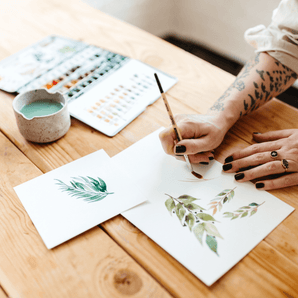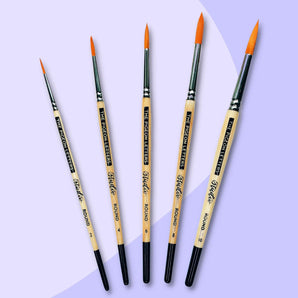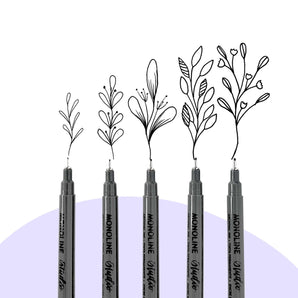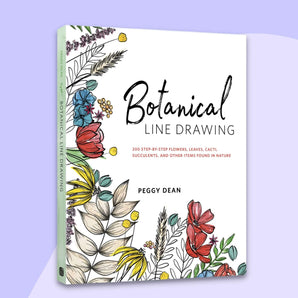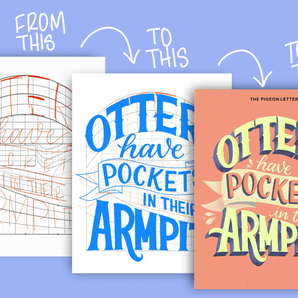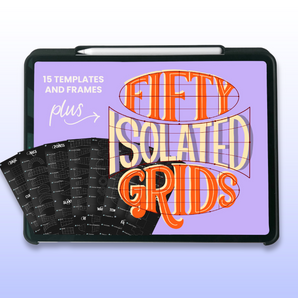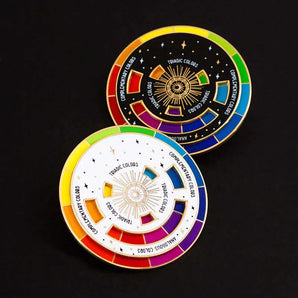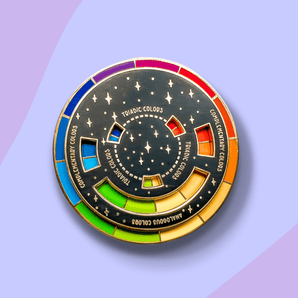Learn how to use canvas to your advantage by using these tips and techniques to elevate your watercolor game! Painting on canvas with watercolor is fairly simple once you get the hang of it. I’m here to show you how!
Hi! I’m Vanessa Lesniak and I am so excited to take you step by step through the process of painting this magical piece.
Supplies:
- 4x6 canvas panels made with 100% cotton
- The Pigeon Letters studio brushes in a variety of sizes
- Paper towel
- Opaque white paint
- Watercolor paint (I use The Sprout Creative paints in Chesapeake Grey, Indigo and Dreams)
Before we start the process, here’s a few things to keep in mind when picking canvas panels:
- Find a size that works for you, they come in bulk so you’ll have many chances to keep trying.
- Pick canvas panels that are 100% cotton, they will help the watercolor soak in nicely and even help with water retention.
- Make sure that the canvas panels you pick are acid free (archival quality), it will help prevent yellowing and decaying of your canvas.
- Pick a canvas that is primed, with or without Gesso. You can also prime one yourself by applying a layer of gesso before you paint.
Watch the tutorial now!
Step 1: Paint with Your Lightest Color
We will be working from lightest to darkest, beginning with a wet on dry technique (wet brush, dry canvas). Using a big brush (I use a size 14), alternate adding light layers of paint with clean water.

Water typically sits on top of the canvas, with minimal soaking in and watercolor does not flow as well on canvas, so if you want some movement in your piece, manually pick up the canvas and tilt it to move the paint.

Step 2: Apply a Second Layer of the Same Color
Apply a second layer of your first color, this time make it a bit darker by saturating your brush with paint and using less water. Gently dab the paint onto your canvas, avoid brushing it on. Leave some light layers underneath, you want to be able to see both layers. Tilt your canvas to encourage a bit of flow.


Grab yourself a set of artist-grade, cruelty-free brushes that you will fall in love with.
Step 3: Wet Your Canvas Edges
The canvas wraps around the edges of the panel, so let’s encourage the flow. Thoroughly wet the edges of your canvas so that any pint will drip down the sides.

Step 4: Create Depth
Switch to a smaller brush (I use a size 6) and a darker color. As the canvas begins to get wetter, I encourage you to add a paper towel under your canvas in order to protect your desk. While the canvas is still wet, add the darker color to the edges in order to add depth to your piece. I also enjoy adding the slightest bit to the inside in order to add dimension. Tilt the canvas to encourage a bit of flow.

Step 5: Add in Your Final Layer
For the final layer, pick a soft color that will go well with the colors you chose for your canvas. Dab it on sparingly, making sure to leave plenty of light spaces.

Step 6: Tips for Drying Your Canvas
If you allow your canvas to dry naturally, it will take quite a long time as it is fully saturated with water and paint. You can rush the process a bit using a heat gun or hair dryer. Some things to keep in mind while using an external heat source:
- Keep the heat gun far from your canvas to avoid burning it
- Keep the heat gun in constant motion. Failing to do so will result in uneven drying and possibly some heat/burn spots.
- Since the water and color sit on top of the canvas without sinking in, when you begin drying, the paint/water mixture will move around with the flow of air. The flow of water/paint will give you a beautiful final piece with plenty of depth
Step 7: Add Stars
With a small brush and your white color (I use Copic Opaque White), load your brush with white and gently tap onto your canvas. Rotate your hand, or the canvas, as you are tapping in the color so give it a. less structured look

Step 8: Add Your Final Touch
Using a liner brush, add stars by drawing a cross and then a light X in the middle of it. Spread these stars throughout your piece and you are done!

See all of Vanessa’s tutorials on the blog!
Vanessa spent 16 years as a social worker and originally began experimenting with watercolor as a form of self care. It soon became a profound passion. With the encouragement and support of her wife and 3 daughters, she became a full time artist and small business owner, with a line of Artisanal Handmade Watercolors. She now shares her passion through workshops and online tutorials.





